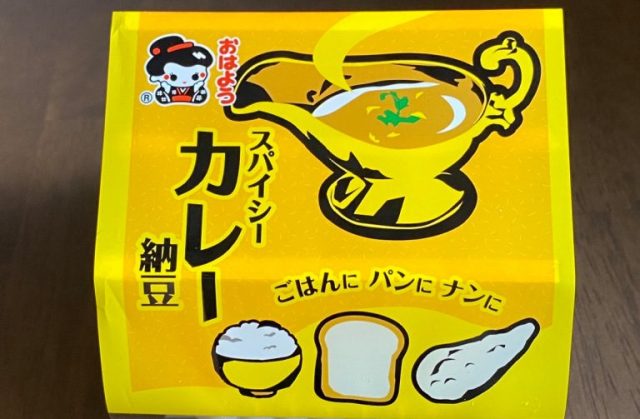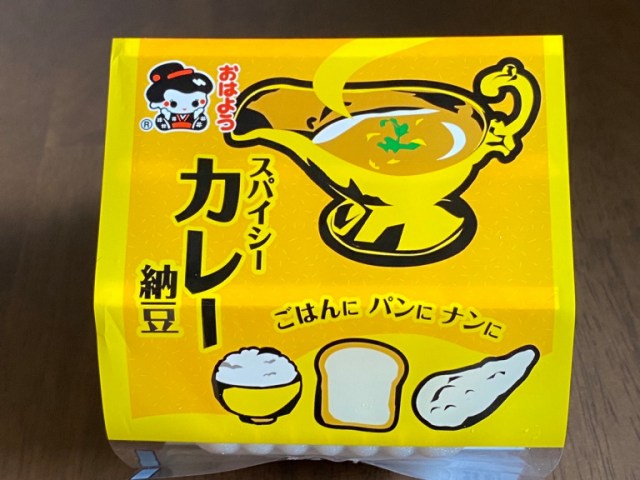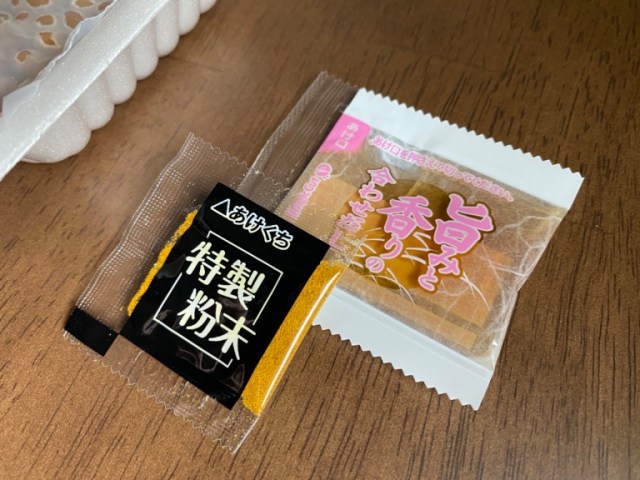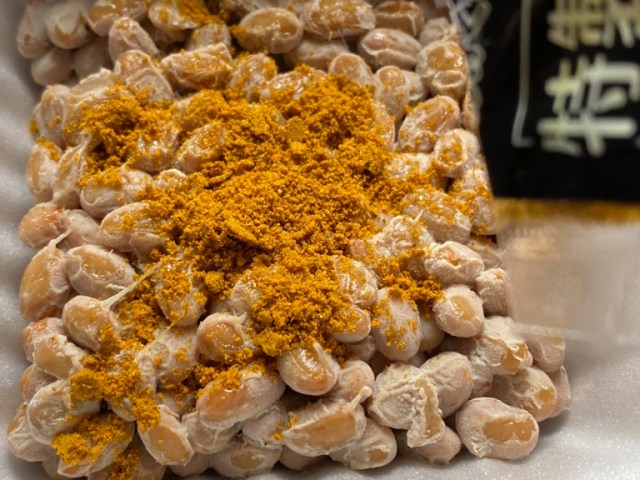
How will the power of curry fare against one of Japan’s most notorious dishes?
Do you like natto? Natto is the Japanese term for fermented soybeans, and though it’s rather popular in Japan and is well-regarded as a health food, it’s notoriously unpleasant to most palates that are unfamiliar with it.
Our Japanese-language reporter Saya Togashi, who is very familiar with natto, found a bright yellow packet of natto while grocery shopping that alleged to be curry powder-flavored. She paid the 95 yen (US$0.87) asking price and took it home to experience it for our benefit.
▼ “Spicy curry natto—have it on rice, bread or naan!” exclaims the bright packaging.
Looking more closely at the packaging, Saya saw that the curry powder in question contained a plentiful blend of spices: turmeric, cilantro, cumin, fenugreek, black and red pepper, and dried citrus peel. In total, more than thirty spices combine to create this flavorful product. Opening the packet revealed two sachets: one of the typical dashi stock served with natto, the other a mix of “special powder”.
▼ Sounds trustworthy.
She set up her plastic container of fermented soybeans and tore open the sachet of special powder. The rich aroma of curry immediately filled the room. Spicy, tantalizing, and a world away from the astringent flavor of natto. Previous curry natto products appear to have used curry paste as their base, but this? This was raw spice.
So impressed was Saya with the powder that she ignored the package’s directions to mix it into a sauce before adding it to the natto.
▼ Direct spice hit!
She mixed all of the special curry powder into the mass of soybeans and reveled as it became sticky, stringy, and glutinous, as natto is want to do. Having activated all those nattokinase enzymes, the place began to smell less like curry and more like natto.
▼ Mix it up well…
▼ Now it’s as sticky and stringy as natto should be.
To be honest, Saya herself is not much of a fan of sticky natto. Even when she adds a sauce or green onions to her natto, she doesn’t mix it very much lest it gets too sticky. But clearly, the intent of this product is to ensure customers mix it well and introduce lots of glutinous strings.
Time to try a bite.
Though the natto overwhelmed Saya’s mouth with spices, it wasn’t spicy at all. It was lacking the painful heat associated with curry…and it was also lacking in terms of sheer curry presence. The natto itself was clearly the star of the show here, with the spectrum of spices only serving to accentuate its raw, fermented might.
It was so intensely natto-esque, in fact, that Saya had to turn to the aid of the dashi stock to stand a chance of finishing it. It too had a gentle curry flavor; she described it as tasting somewhat like curry soba noodles. The added moisture made it much easier to mix.
▼ Yummy.
So how does it taste when the dashi broth is included?
The mellow broth actually subdued some of the natto’s intense natto-tude, and allowed the spice powder to better harmonize with the natural natto flavor. Mellow notes of bonito and kelp made themselves known at first before the curry flavor finally sank in. Saya marveled at how layered the taste was.
So in the end, the curry spice flavored natto tasted much more like natto than like curry spice. This makes it less appetizing to natto newcomers, but more experienced soybean savants will be able to appreciate the depth and quality of the flavor thanks to the added element of the curry spices.
A kimchi-flavored natto product seems to be in the works, so maybe this is the dawn of a brand new era of flavored natto. Personally? We’re waiting on tenterhooks for an orange juice flavored version.
Images © SoraNews24
[ Read in Japanese ]









 Our natto maniac verifies the legitimacy of fermented soybean-flavored potato chips【Taste test】
Our natto maniac verifies the legitimacy of fermented soybean-flavored potato chips【Taste test】 Soap made from natto coming to Tokyo a week after Natto Day
Soap made from natto coming to Tokyo a week after Natto Day Instant noodle company combines yakisoba noodles with fermented natto bean topping
Instant noodle company combines yakisoba noodles with fermented natto bean topping New product stirs your natto 424 times to bring out its ultimate flavor
New product stirs your natto 424 times to bring out its ultimate flavor We try ice cream with a topping of natto fermented soybeans, because the Internet told us to
We try ice cream with a topping of natto fermented soybeans, because the Internet told us to McDonald’s new Happy Meals offer up cute and practical Sanrio lifestyle goods
McDonald’s new Happy Meals offer up cute and practical Sanrio lifestyle goods Studio Ghibli glasses cases let anime characters keep an eye on your spectacles
Studio Ghibli glasses cases let anime characters keep an eye on your spectacles All-you-can-drink Starbucks and amazing views part of Tokyo’s new 170 meter-high sky lounge
All-you-can-drink Starbucks and amazing views part of Tokyo’s new 170 meter-high sky lounge Super Nintendo World expansion gets delayed for several months at Universal Studios Japan
Super Nintendo World expansion gets delayed for several months at Universal Studios Japan Kyoto’s 100 Demons yokai monster parade returns!
Kyoto’s 100 Demons yokai monster parade returns! More foreign tourists than ever before in history visited Japan last month
More foreign tourists than ever before in history visited Japan last month We cooked Japan’s 2,000-yen mail-order Ramen of the Year, but was it worth it?【Taste test】
We cooked Japan’s 2,000-yen mail-order Ramen of the Year, but was it worth it?【Taste test】 The oldest tunnel in Japan is believed to be haunted, and strange things happen when we go there
The oldest tunnel in Japan is believed to be haunted, and strange things happen when we go there Hey, Japanese taxi driver! Take us to your favorite restaurant in Tsuruga City!
Hey, Japanese taxi driver! Take us to your favorite restaurant in Tsuruga City! What happens when you use a facial massage roller for two weeks straight?
What happens when you use a facial massage roller for two weeks straight? Disney princesses get official manga makeovers for Manga Princess Cafe opening in Tokyo
Disney princesses get official manga makeovers for Manga Princess Cafe opening in Tokyo Starbucks reopens at Shibuya Scramble Crossing with new look and design concept
Starbucks reopens at Shibuya Scramble Crossing with new look and design concept Beautiful new Final Fantasy T-shirt collection on the way from Uniqlo【Photos】
Beautiful new Final Fantasy T-shirt collection on the way from Uniqlo【Photos】 Is the new Shinkansen Train Desk ticket worth it?
Is the new Shinkansen Train Desk ticket worth it? Foreign English teachers in Japan pick their favorite Japanese-language phrases【Survey】
Foreign English teachers in Japan pick their favorite Japanese-language phrases【Survey】 Japanese convenience store packs a whole bento into an onigiri rice ball
Japanese convenience store packs a whole bento into an onigiri rice ball We try out “Chan Ramen”, an underground type of ramen popular in the ramen community
We try out “Chan Ramen”, an underground type of ramen popular in the ramen community Studio Ghibli releases Kiki’s Delivery Service chocolate cake pouches in Japan
Studio Ghibli releases Kiki’s Delivery Service chocolate cake pouches in Japan Japan’s bone-breaking and record-breaking roller coaster is permanently shutting down
Japan’s bone-breaking and record-breaking roller coaster is permanently shutting down New definition of “Japanese whiskey” goes into effect to prevent fakes from fooling overseas buyers
New definition of “Japanese whiskey” goes into effect to prevent fakes from fooling overseas buyers Our Japanese reporter visits Costco in the U.S., finds super American and very Japanese things
Our Japanese reporter visits Costco in the U.S., finds super American and very Japanese things Studio Ghibli unveils Mother’s Day gift set that captures the love in My Neighbour Totoro
Studio Ghibli unveils Mother’s Day gift set that captures the love in My Neighbour Totoro Foreign passenger shoves conductor on one of the last full runs for Japan’s Thunderbird train
Foreign passenger shoves conductor on one of the last full runs for Japan’s Thunderbird train Domino’s Japan now sells…pizza ears?
Domino’s Japan now sells…pizza ears? New Japanese KitKat flavour stars Sanrio characters, including Hello Kitty
New Japanese KitKat flavour stars Sanrio characters, including Hello Kitty Kyoto creates new for-tourist buses to address overtourism with higher prices, faster rides
Kyoto creates new for-tourist buses to address overtourism with higher prices, faster rides Sales of Japan’s most convenient train ticket/shopping payment cards suspended indefinitely
Sales of Japan’s most convenient train ticket/shopping payment cards suspended indefinitely Sold-out Studio Ghibli desktop humidifiers are back so Totoro can help you through the dry season
Sold-out Studio Ghibli desktop humidifiers are back so Totoro can help you through the dry season Japanese government to make first change to romanization spelling rules since the 1950s
Japanese government to make first change to romanization spelling rules since the 1950s Ghibli founders Toshio Suzuki and Hayao Miyazaki contribute to Japanese whisky Totoro label design
Ghibli founders Toshio Suzuki and Hayao Miyazaki contribute to Japanese whisky Totoro label design Doraemon found buried at sea as scene from 1993 anime becomes real life【Photos】
Doraemon found buried at sea as scene from 1993 anime becomes real life【Photos】 Tokyo’s most famous Starbucks is closed
Tokyo’s most famous Starbucks is closed One Piece characters’ nationalities revealed, but fans have mixed opinions
One Piece characters’ nationalities revealed, but fans have mixed opinions We asked a Uniqlo employee what four things we should buy and their suggestions didn’t disappoint
We asked a Uniqlo employee what four things we should buy and their suggestions didn’t disappoint Princesses, fruits, and blacksmiths: Study reveals the 30 most unusual family names in Japan
Princesses, fruits, and blacksmiths: Study reveals the 30 most unusual family names in Japan Custard pudding with natto fermented soybeans? We try the new dessert craze sweeping Japan
Custard pudding with natto fermented soybeans? We try the new dessert craze sweeping Japan All-you-can-eat stinky fermented soybeans come to Ginza, if that’s your thing
All-you-can-eat stinky fermented soybeans come to Ginza, if that’s your thing We tried making natto the old-fashioned way, and the result was unexpected but delicious 【SoraKitchen】
We tried making natto the old-fashioned way, and the result was unexpected but delicious 【SoraKitchen】 Mizkan develops world’s most “beautiful” natto, Mr. Sato takes it for a spin
Mizkan develops world’s most “beautiful” natto, Mr. Sato takes it for a spin Toast with fermented soybeans and honey may not be good-looking, but it is good eating
Toast with fermented soybeans and honey may not be good-looking, but it is good eating New magic powder purports to make natto edible even for bean-haters
New magic powder purports to make natto edible even for bean-haters Instant natto soba a suspiciously hot item so we check it out
Instant natto soba a suspiciously hot item so we check it out Eat Japanese cuisine like an epicure with the updated Ultimate NTO natto mixer from Takara Tomy
Eat Japanese cuisine like an epicure with the updated Ultimate NTO natto mixer from Takara Tomy Fermented soybean shaved ice pushes the envelope of summertime sweets
Fermented soybean shaved ice pushes the envelope of summertime sweets There’s no reason not to play with your food with this natto in Nanoblock form
There’s no reason not to play with your food with this natto in Nanoblock form Natto for beginners? How to half-make Japanese fermented soybeans at home【SoraKitchen】
Natto for beginners? How to half-make Japanese fermented soybeans at home【SoraKitchen】 We try a new natto coffee ice cream that took 17 months to perfect
We try a new natto coffee ice cream that took 17 months to perfect Natto allergy is caused by jellyfish stings, says surprising Japanese study
Natto allergy is caused by jellyfish stings, says surprising Japanese study Survey ranks the most popular Japanese curry dishes during winter
Survey ranks the most popular Japanese curry dishes during winter Life hack for living in Japan: How to painlessly remove the wrapper from a pack of natto
Life hack for living in Japan: How to painlessly remove the wrapper from a pack of natto Japan’s favorite curry rice restaurant teams up with convenience store for Super Spicy Curry Buns
Japan’s favorite curry rice restaurant teams up with convenience store for Super Spicy Curry Buns
Leave a Reply